
World Premiere Review!
Rogue Audio Cronus Magnum III Int. Amp. / Phono Stage
Excellent build quality combined with the sonic performance of vacuum tubes. Review By Ron Nagle
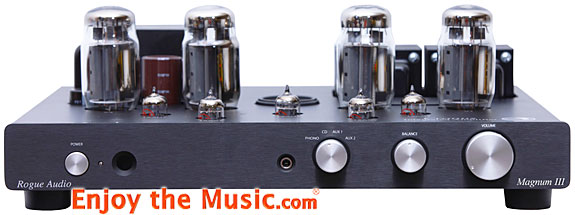
The name Cronus is past down to us from an ancient Greek myth. Krónos was the leader and youngest of the first generation of Titans. I did my usual on line peeking and sleuthing and found images of the Cronus, a very retro looking open frame amplifier. But while all of those pictures looked like the subject of this evaluation they were actually photos of an earlier version of the Magnum II amplifier. So these photos were taken before I ever got my hands on this review sample. This story is about the new extensively upgraded Cronus Magnum III. When I opened the box and peeled back the packing I lifted (grunt) an impressive 55 pound amplifier from its cardboard container.
Rogue Audio’s Cronus is a very serious and convincingly constructed component; I didn’t see any signs of money saving cost cutting construction anywhere. The Amplifier is shipped with five small triodes in place. That is three 12AU7 and two 12AX7 tubes. They are positioned halfway below the top of the chassis mounted on recessed tube sockets. There are four Pentode KT120 output tubes that are shipped in their original Soviet Tung-Sol boxes. They are numbered one to four corresponding to their individual designated tube sockets. All the tube types and locations are conveniently silk screen painted on the top of this black anodized amplifier. At the center of the amplifier chassis is a round D’Arsonval DC milliamp bias meter.
Features
The Cronus Magnum III is designed to be the heart of your audio system. It is versatile and has provisions for an output jack for a Head Phone amplifier and a very extensively upgraded Phono Amplifier. Also provided is a milled aluminum Remote Control. The Cronus front face sports three control knobs a push button on/off switch and a remote sensor. The control knobs functions are from left to right: a four position input Selector and then Balance, and Volume.
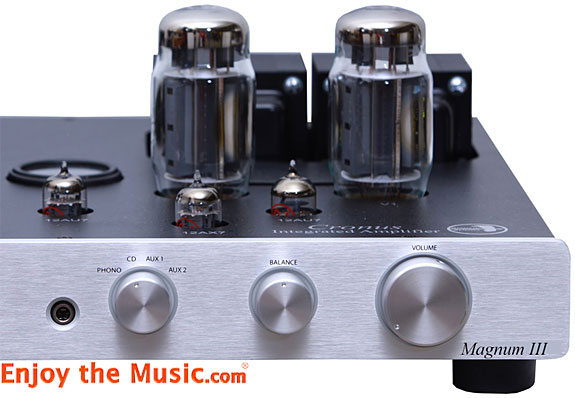
However the Remote Control is limited, it can only adjust the volume up or down or mute the amplifiers output. Looking at the back of the Cronus there is a small toggle switch to change the amplifiers output configuration from either Triode or to Ultralinear. The output can be changed while the amplifier is operating. Love that feature!
There are four pairs of gold plated unbalanced RCA inputs and an additional two pairs of RCA outputs labeled variable and fixed. The four inputs are labeled, left to right, Phono, CD, AUX 1, AUX 2. As you can expect, there are very high quality gold plated five-way loudspeaker binding posts for left and right channels made by Cardas. There’s a 5 Ampere main fuse and detachable IEC connection for the power cord.
An Inside Look
There are a few different design (tempted to call them novelties) features built into this amplifier. The three features are actually three adjustments that you may have to make, and all three are inside the amplifier. The first is in my experience the most unusual. The amplifier is factory set to match 8 Ohm speakers. But you can adjust the speaker load resistance to either 4 or 8 Ohm’s depending upon your speakers. But this involves a bit of work. You need to:
- With a Phillips screwdriver remove the 14 screws holding the top cover. At this time you would have removed the four KT120 output tubes. Insure the amplifier has been turned off for about 30 minutes and the amplifier power cord is connected a ground.
- With a 0.5″ wrench remove the outermost nut from the red positive binding post. Leave the black wire with heat shrink on the post.
- Remove the 8 Ohm tap (Green wire marked 8) from the binding post. Careful to leave the black wire with heat shrink on the post.
- Remove the polyurethane tubing from the yellow 4 Ohm wire and lug.
- Place the polyurethane tubing on the 8 Ohm wire and lug.
- Place the 4 Ohm wire onto the binding post, and then replace the outer nut. I did not have to make this change for my reference modified Rosewood 8 Ohm Aurum Cantus V30M loudspeakers.
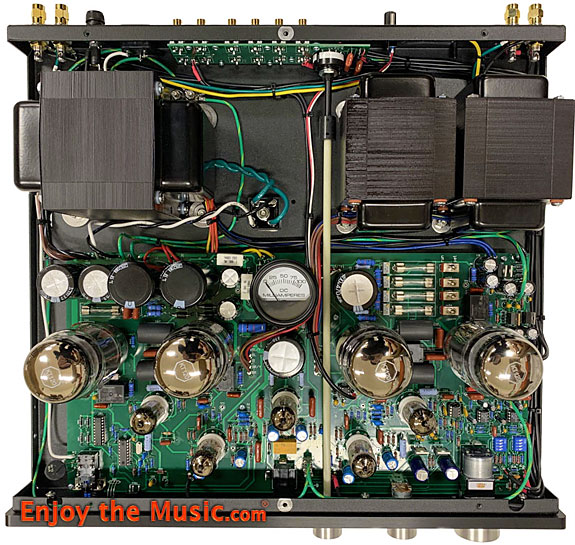
Cartridge Setup
With the top cover removed you can access the settings for the phono amplifier gain and cartridge loading. You can choose either moving magnet (MM) 45dB or moving coil (MC) 60dB gain positions via a small two way switch. The Cronus is shipped with the gain set at 45dB and the load set at 47kOhms. I had to use the higher gain setting, 60dB for my moving coil Denon 301 MKII then set the loading at a 100 Ohms. There are two left and right channel four position DIP switches. You need to set the four individual DIP switch positions to match the values listed in a table within the owner’s manual. The range of resistive loads is shown in eight steps ranging from 30 Ohms to 47kOhms.
A Deeper Bias
The next tertiary adjustment is the tube biasing procedure. The same PC board used to set tube bias also contains an individual 0.25 Ampere slow blow fuse for each tube. Below the top of the chassis under an access cover held in place with two knurled thumb screws is the bias access. At this time the amplifier will have been turned on for approximately 30 minutes. Now with the Volume control turned off and with bias cover removed. You see a small PC Board with four 0.25 Ampere slow blow fuses. That’s one fuse for each KT120 tube (a great trouble shooting advantage). Also, you will see each fuse has a small switch next to it plus a small trimpot (potentiometer). Activate each switch to engage the top cover bias meter. Using the tool affixed to the top of the amplifier, you can easily set the bias with the trimpot to read 35 milliamps. Do the same with each of the four switches at each position one at a time. You may have to periodically reset the bias as the tubes age.
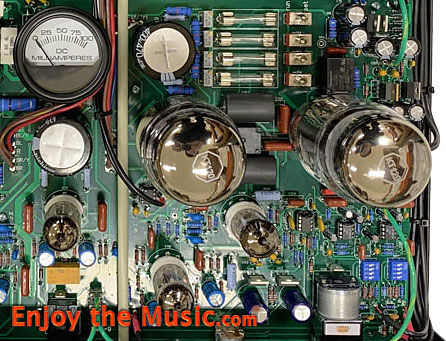
The Sound
I just received a test CD with my British Hi-Fi+ magazine subscription. The CD reads, ISOTEK: The Ultimate System set-up Disc. Even though it is primarily a system set up recording it does have music sound tracks. Reasoning that the Cronus amplifier is now the center of my music system listening to it could be very informative. Part of the test recording contains a series of sound and imaging tracks both left and right, including depth and even a 360 degree sound sweep, all perfectly done. Happy to announce that my music evaluation machine with the Cronus in the system is all neat and tidy and properly set up. Unfortunately, the music tracks on this test CD are just mediocre and do not really test the ability of the Cronus Magnum III. However, I do have a CD that will reveal this amplifiers detailing ability.
Chances are a committed audiophile would own a copy of Nils Lofgren’s SACD Acoustic Live, and so let’s spin it up. Immediately there is a dimensional expansion of the sound scape. The scale of stereo imaging within the performance space, including those in front of the stage, are clear to hear. There are great aural hints of 3D space. Space is what you should expect, and that’s what would be a wonderful characteristic of this vacuum tube powered soundscape. Razor edged transient attack is what you might hear with a solid-state setup, yet Rogue Audio’s Cronus Magnum III integrated tube amplifier with phono stage reveals something far more satisfying. The sound is full of natural resonant harmonic overtones both odd and even. More than that, those overtones decay into silence much more gradually. My favorite Harry Pearson phrase is “Continuousness”, and here it fits nicely.
It’s not at all like early digital delineation. That’s when sound levels subside and they are eliminated as a least significant bit. What I have tried to convey is part of what some have called, “Tonal Body” but I would rather call this simply, the Gestalt! That’s when every part blends together and forms a clear coherent concept. There is another significant tonal characteristic of the Magnum III. On a very good recording It puts spaces around and between parts of the performance. It’s subtle, but it’s like a renaissance masters painting in that the main subject/performer is made evident. The subject is highlighted and separate, in their own space and separate from the background.
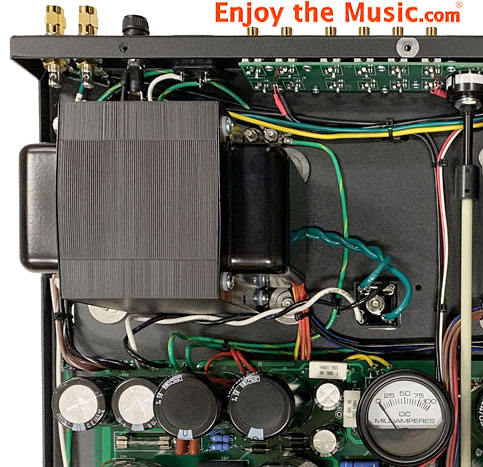
Vinyl
Touting the enhancements Rogue Audio has made to their upgraded phono stage, I was exceedingly curious to give it a try. For this trial I used Roy Hall’s very fine Music Hall Phono interconnect. It is a slightly stiff two wire cable with RCA termination and an integral grounding lead. Just arriving at my door is my purchase of a new vinyl album. Specifically, a very nice picture disc in a gate fold slip case: John Williams, A life In Music, With The London Symphony Orchestra [Decca 02567-49056].
First cut, is the always favorite sci-fi Star Wars opening theme. It was so rewarding for me in summoning such fond memories. Turn the volume up and the soundscape is huge, filling the space behind my speakers nicely. By comparison, my transistor reference Parasound P5 with a phono stage preamplifier and solid-state Sanders power amplifier could get the detail and width dimension spot on, but not the same sense of stage depth and height.
I saved the best for last. A comparison of the Magnum III onboard phono stage and my reference Tavish Design Adagio tube powered phono amplifier, which was reviewed by Enjoy the Music.com in February 2016. For continuity, let’s replay John Williams a life in music and that Stare Wars theme again. It takes the entire Star Wars track and more! But it’s basically a tradeoff between these two fine phono stages. The Cronus Magnum III projects a large and tonally rich panorama that I find satisfying involving and natural. Now this characteristic is easier to hear when the Cronus III amplifier is running in triode mode. On the other hand, my stand alone Tavish amplifier does not paint quite as expansive a stage; it seems to have a little better extension at the top end frequencies. As a result, there are small details buried within the soundscape that sound a bit clearer.
By a slight margin, that same characteristic detailing ability of the Adagio phono amplifier, as compared to the Rogue Audio Cronus Magnum III phono stage operating in either triode or ultralinear mode, makes the Tavish Adagio sound a touch more dynamic. So you get six measures of detail and a half dozen of tonality. The true question you need to ask yourself is what would you prefer.
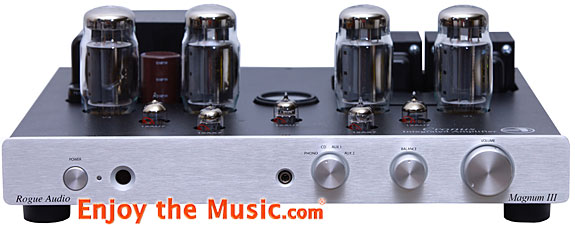
Conclusion
Of course everyone is different and has their preferences. Having described some of the basic differences, I leave it up to you to decide. Of course every other thing comes into play, too. What size is your room, what kind of speakers do own, and most importantly what kind of music do you like. The performance of Rogue Audio’s Cronus Magnum III is very easy to listen to and satisfying in both modes. I could easily build a very rewarding system around this integrated amplifier with phono stage. Rogue Audio has my admiration for the overall build quality and sonic performance of their Cronus Magnum III musical instrument. My advice, you need to audition the Rogue Cronus Magnum III even if you only had but one motivation. And that motivation is your love of music.
Remember to enjoy the music and from me Semper Hi-Fi.
| Tonality |     |
| Sub–bass (10Hz – 60Hz) |    |
| Mid–bass (80Hz – 200Hz) |     |
| Midrange (200Hz – 3,000Hz) |      |
| High Frequencies (3,000Hz On Up) |     |
| Attack |     |
| Decay |     |
| Inner Resolution |     |
| Soundscape Width Front |      |
| Soundscape Width Rear |      |
| Soundscape Depth Behind Speakers |     |
| Soundscape Extension Into Room |     |
| Imaging |     |
| Fit And Finish |      |
| Self Noise |     |
| Value For The Money |      |
SpecificationsType: Vacuum tube stereo integrated amplifier with MM / MC phono stage
Power Output: 100 Wpc stereo
Frequency Response: 20Hz to 30kHz
Output Taps: 4 and 8 Ohm
Tube Compliment: Two 12AX7, three 12AU7, four KT120 output tubes
Inputs: Four unbalanced RCA
Outputs: Unbalanced RCA for subwoofer or bi-amp’ing
Gold plated RCA inputs
Gold plated binding posts
Phono Gain: 45 and 60 dB
Headphone Amplifier: 2 Watts
Aluminum remote with volume and mute
Detachable IEC power cord
Dimensions: 18″ x 17.5″ X 6.75″ (WxDxH)
Designed and hand built in the USA
Price: $2995
Company Information
Rogue Audio
PO Box 1076
Brodheadsville, PA 18322
Voice: (570) 992-9901
E-mail: info@rogueaudio.com
Website: www.RogueAudio.com















Want to join discussion?
Feel free to contribute!